|
Kampen, Overijssel
Kampen (Dutch pronunciation: [ˈkɑmpə(n)] ⓘ) is a city and municipality in the province of Overijssel, Netherlands. A member of the former Hanseatic League, it is located at the lower reaches of the river IJssel. The municipality of Kampen had a population of 54,474 in 2021 and covers an area of 161.79 square kilometres (62.47 square miles). Kampen is located in the North West of Overijssel and is the largest city in this region. The city of Kampen itself has around 37,000 inhabitants. Kampen has one of the best preserved old town centres of the Netherlands, including remains of the ancient city wall (of which three gates are still standing) and numerous churches. Also notable are the three bridges over the IJssel which connect Kampen with IJsselmuiden and Kampereiland, the agricultural area between the branches which form the IJssel delta, and a windmill (d' Olde Zwarver – the Old Vagabond). Since November 2018, the town and some communes are on a river island. Between the 14th and 16th century it was one of the biggest towns in the Northern Netherlands (modern day European Netherlands). The town is about 90 kilometer northeast of Amsterdam. Traditionally people in Kampen speak a variation of the Sallands dialect, known as Kampers. HistoryMiddle AgesBy 1150, there were already wooden buildings on the site where Kampen is currently located. The name Kampen, however, is not mentioned until 1277. The city has had city rights since 1236. As a result of its convenient location on the busy trade route between the Zuiderzee and the Rhine, Kampen quickly developed from simple settlements into a prosperous trading town, to become one of the most powerful and leading cities of northwestern Europe. In the 14th century, Kampen exchanged with the bishop of Utrecht, Jan van Arkel, the Mastenbroek polder against the right to increase the IJsseldelta. The silting up of the IJssel brought a gradual end to the prosperity of Kampen from 1430 on. For a long time Kampen did not want to sign a union and make economic and political concessions to other cities, as was usual in the Hanseatic League. When the County of Holland went to war with the Hanseatic League this situation came to an end: the city was forced to choose a side in the war. Kampen was originally more oriented toward the Baltic trade and commerce with the hinterland of the Rhine, and therefore in 1441 formally joined the Hanseatic League. The city had much influence in the League; despite loud protests from the other towns in lower reaches of the IJssel and from other Hanseatic cities, the League agreed in 1448 to build a bridge over the river.[5] This project was accomplished in just five months. With this bridge Kampen hoped to be able to develop closer relationships with the hinterland. Post-Medieval  On 11 August 1572 Kampen was conquered from the Spaniards by Willem van den Bergh, a brother of William of Orange. After the massacre of Zutphen on 15 November, the city voluntarily surrendered to the Spanish. In 1578, the city changed ownership again after the Siege of Kampen, led by George van Lalaing. Due to its right to increase the IJsseldelta, Kampen was owner of the growing Kampereiland. From 1500 the islands were leased. The rents were so large that the city did not need to raise taxes. In October 1670, Kampen was the first of four Dutch cities to raise capital by issuing a Tontine.[6] The Franco-Dutch War, fought by the Republic of the United Netherlands against the Kingdom of France, Sweden, the Bishopric of Münster, the Archbishopric of Cologne and the Kingdom of England, marked a definitive end to the enormous power of the city. Kampen only became well known again in the 19th century. The city was difficult to reach from the sea, because the surrounding wetlands became silted up and shallow. During the preceding centuries, the watercourse of the river IJssel was dredged several times, but the costs were relatively high and within a few years, the river silted up again. As the IJssel had several delta-like mouths here, the main route of the river shifted several times. In the 19th century, a new strategy was put in place to counter this problem: some watercourses were dammed to allow for more water at a higher speed through one or two main routes. This had the advantage that less sand and silt were deposited and resulted in a river course that "swept itself clean". A key figure in this story is city architect Nicolaas Plomp, who, besides his work for the current IJssel front of the city of Kampen, was also involved in hydraulic engineering. Due to the emerging industry in the 19th century and the importance of roads and railways for the economy, highways and paved roads were constructed to replace transportation over sand and mud roads. Geography 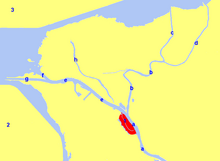
Kampen is part of the province of Overijssel ('Over-IJssel' i.e. (mostly) trans-/across the river IJssel, as seen from the perspective of the bishopric of Utrecht by which it was held until 1528) in the Eastern part of The Netherlands, situated between the provinces of Gelderland, Flevoland, Drenthe and Friesland. The city of Kampen is situated at the mouth of the river IJssel. Opposite Kampen, along the IJssel, lies IJsselmuiden, which is the second largest residential nucleus of the municipality Kampen. The municipality of Kampen has five other population centers: Grafhorst, 's-Heerenbroek, Kamperveen, Wilsum and Zalk. CultureHistorical buildings and other landmarksKampen has a large number of old to very old buildings, including remains of the ancient city wall (whose city gates are still standing) and the Church of St Nicholas (Bovenkerk). The structure of the walled fortress city is still visible in the streets. Significant structures include:
Throughout the town of Kampen, there are colorful murals which are in fact old commercials for now-defunct business in Kampen. These murals, which include Art Nouveau influences, were made by local artists and are now referred to as "frescoes of the middle class". As a result of current municipal policy, wherever these murals are discovered under old plaster, they are restored to their former glory. A number of better or lesser known people with a certain connection with Kampen is honoured with a commemorative stone bearing their name and a single-sentence characterization of their personality or achievements, incorporated into the pavement of the Oude Raadhuisplein (formerly Koeplein), the square in between the old town hall, the former Post Office and Nieuwe Toren. Gallery
Festivals and eventsAn annual festival during the summer months is the Kamper ui(t) day. The name is derived from a series of folk tales in which the inhabitants of Kampen were portrayed as stupid. Another summer event is the Full Color Festival, which is organized annually. Every third Saturday of August, a comics event, called the Kamper Stripspektakel, is organized with over 100 booths. Once every three years Sail Kampen takes place, a sailing spectacle with (old) sailing ships. A weekend before Christmas Christmas in Oud Kampen is organized. There is street theater, where pieces of famous musicals are played, and mid-nineteenth-century characters are walking around the city. SportsKampen is the home of football team Go Ahead Kampen and its rivals Dos Kampen, KHC Kampen, VV Kampen and IJVV. Humor The foolish wisdom of the residents of the Dutch city of Kampen gave rise to the term "Kamper onion" (Kamper ui, plural: Kamper uien) for town-of-fools type stories, as well for the "Kampersteur" ("Kamper Sturgeon") dish, which is made not of sturgeon, but of eggs: to greet a visiting bishop the Kampers caught a large sturgeon, and to keep it fresh they tied a cowbell to it and let it back in water. When the bishop arrived, the fish was gone, and a dish made of eggs was served instead.[7] The "onion" in "Kamper onion" comes from the tale, variants of which are known in various cultures: a tramp convinces a farmer and his wife that he knows how to cook a nutritious stew from onion and salt. But while cooking he adds plenty of other stuff "to improve the taste". Twin townsKampen is twinned with:
Transportation The Kampen railway station opened in 1865 as terminus of the Kamperlijntje branch from Overijssel's capital city Zwolle. It is served by a non-stop diesel service on a single track. The line was renovated in 2017 to be electrified. In December 2017, Keolis Nederland took over the line, after Nederlandse Spoorwegen lost the line in a tendering process. There is an alternative railway connection with Zwolle via the Hanzelijn, which links Zwolle with Amsterdam via Dronten, Lelystad and Almere. It was inaugurated by Queen Beatrix in December 2012. Kampen Zuid railway station was built a few kilometers south of Kampen near the junction of the national roads N50 and N764, where a new residential development is planned. Somewhat confusingly, there was a Kampen Zuid railway station in existence before, between 1 October 1913 and 15 May 1934. This was the terminus of the Kampen–Hattem railway line, which connected with the Zwolle–Apeldoorn service via Wapenveld and Heerde. Surface roads connecting the city include N760, N763, N765 and N307. EducationKampen had two theological universities: the Theological University of the Protestant Church in the Netherlands (PThU) and the theological college of the Reformed Church of the Netherlands (TUK). Notable residents 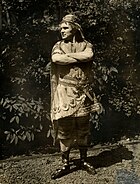 The arts
Public thinking & public service
Sport
Other
References
External linksWikivoyage has a travel guide for Kampen, Overijssel.
|
||||||||||||||||||||||||||||||||||||||||||||||||||||||||











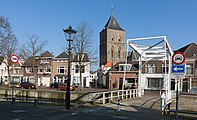

![Protestant Theological University Kampen [Protestantse Theologische Universiteit vestiging Kampen]](http://upload.wikimedia.org/wikipedia/commons/thumb/8/87/2007-04-23_14.14_Kampen%2C_theologische_universiteit.JPG/160px-2007-04-23_14.14_Kampen%2C_theologische_universiteit.JPG)




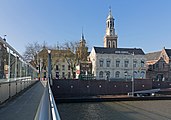
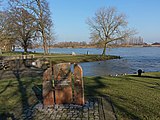
![The new Anabranch called Reevediep [nl]](http://upload.wikimedia.org/wikipedia/commons/thumb/7/72/Onderdijksewaard7.jpg/161px-Onderdijksewaard7.jpg)



